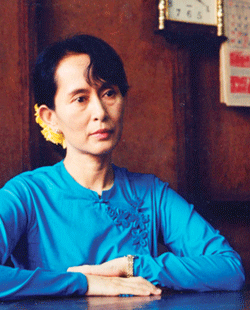Magazine
COVER STORY
The Faces of Burma 2005
By The Irrawaddy
DECEMBER, 2005 - VOLUME 13 NO.12
(Page 5 of 13)
Zarni would later reverse his previous position on Burma by coming out against economic sanctions, criticizing democratic opposition leader Aung San Suu Kyi and traveling to Rangoon to meet with the country’s ruling generals.
USCB efforts—particularly its international campaign to celebrate Suu Kyi’s 60th birthday—have demonstrated how coordinated action around the world can make the Burmese junta vulnerable and focus media attention on opposition activities. Aung Din, considered by many to have close ties with the political establishment in Washington, often appears on short wave radio broadcasts. While some critics have branded him a hardliner, Aung Din says that he is simply a “principled activist” working in exile for the benefit of the opposition movement in Burma.
Aung San Suu Kyi [Opposition Leader]
Since her detention in 2003 after her convoy was attacked by thugs backed by the junta, pro-democracy leader Aung San Suu Kyi has been silent (read: silenced) and cut off from all communication with the outside world.
 At first she was held in an undisclosed detention center before being confined under house arrest. In late November 2005—the year of her 60th birthday—the house arrest order was extended by another year.
At first she was held in an undisclosed detention center before being confined under house arrest. In late November 2005—the year of her 60th birthday—the house arrest order was extended by another year.Out of touch with her supporters and the general public, Suu Kyi may have suffered a fall in popularity, but she is still a focus of national attention. The irony is that if she were to vanish from the public domain, if indeed she were to be forgotten, the regime would in all likelihood release her. As it is, she remains a symbol of the democracy movement and poses an enduring threat to the paranoid regime.
Contacts were established and lines of communication opened between her and government liaison officers in 2004, just before the resumption of the military-sponsored National Convention. Since the downfall of former prime minister and intelligence chief Khin Nyunt, no one has been assigned to the role of liaison officer between Suu Kyi and the government.
It’s a lonely life for Suu Kyi in her heavily guarded lakeside home in Rangoon. Police and intelligence officials seal off the road in front of her house, which stands forlornly behind a fence festooned with NLD banners. Only her physician is allowed to pass regularly through the cordon.
In her previous terms of house arrest, UN special envoys and family members were allowed to visit her, and through them she was able to send out messages to the outside world—political statements and also descriptions of her health and state of mind.
The Peopls who Speak of NLD
Unlike in the year 2004, when the embattled National League for Democracy endured as much friendly fire as enemy aggression and was wracked by the controversial dismissal, suspension and demotion of its radical members, the opposition party in 2005 enjoyed greater stability and a better image. But none of the NLD’s usual critics, Burmese as well as foreigners, appears to recognize this development.
Progress was especially notable in early 2005 with the appointment by the party’s octogenarian leadership of five outspoken second-liners as NLD media contacts. Interestingly, unlike most NLD founders, many of those who have now risen to prominence were not involved in politics before the 1988 pro-democracy uprising. They have their stories of commitment to tell.
“The 1988 movement transformed my life,” says Myint Thein, the NLD’s successful candidate in the 1990 election, representing Kyaikmayaw Township in Mon State. He is now one of the party’s most articulate spokespersons.
An officer of the Co-operative Ministry from the 1970s until the late 1980s, Myint Thein was forced to retire from his job because of his involvement in 1988 demonstrations against the so-called socialist government. He then helped found the NLD’s Kyaikmayaw Township office.
Myint Thein has endured four terms of imprisonment and detention, including nearly three years in a detention center without trial. He was sent to the detention center in 1998 after joining the NLD headquarters two years earlier to assist Aung San Suu Kyi.
“Daw Suu’s moral integrity and treatment towards us have had a tremendous impact on me,” says Myint Thein, who acted as the NLD leader’s personal driver in the late 1990s.
Now in his 60s, Myint Thein gets along with the NLD’s elderly leaders, who are regarded by some of the younger members as authoritarian and lacking in strategic vision. “We, the younger, should learn from the experiences of older leaders,” he told The Irrawaddy.
« previous 1 | 2 | 3 | 4 | 5 | 6 | 7 | 8 | 9 | 10 | 11 | 12 | 13 next page »
more articles in this section
